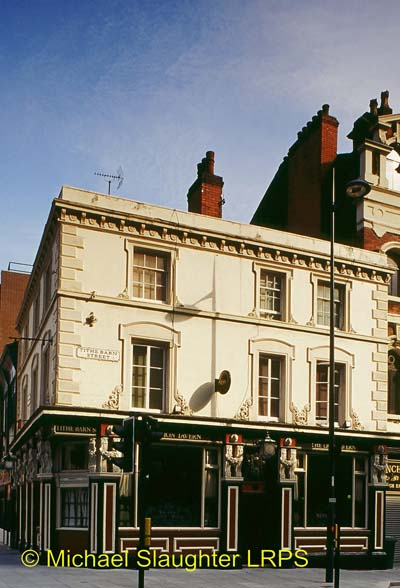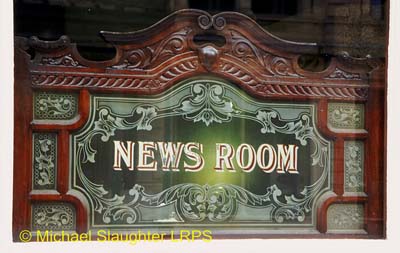|
MERSEYSIDE - Liverpool, City Centre, Lion National Inventory of Historic Pub Interiors Part Two 67 Moorfields, Liverpool, L2 2BP (corner Titheburn St) Tel: 0151 236 1734 Opening Hours: 11 to 11 Draught Beer & Cider: Lees Bitter, Youngs Bitter, Caledonian Deuchars IPA, guest beers Public Transport: Railway Station: Liverpool Lime Street; Mersey Rail: Moorfield Listed Status: Grade II View this pub on a local map
A very fine pub in central Liverpool which forms an interesting comparison with the Stork in Birkenhead and the Prince Arthur in north Liverpool. Like them it is a Victorian building (in this case of c.1865) remodelled about in the early twentieth century. They all share corner sites with the public bar occupying the angle and surrounded by an L-shaped corridor. All too have beautiful tiled dadoes in their corridors dating from Edwardian remodelling schemes (as seen in our picture). A further similarity is the way the corridor works to provide a drinking area.
Discovery of the documents submitted to the licensing justices enabled former licensee, John ODowd, to trace the evolution of the pub to its present form. Back in 1903 a plan shows the public bar laid out as it is now. There was a snug behind it in the heart of the building and left of this, and on the site of the present toilets, a public room labelled parlour. Then in 1915 the Lion expanded by taking in the building next door at 28 Tithebarn Street also a licensed premises. This enabled the L-shaped corridor to be created round the public bar and the formation of two rooms behind this - a news room in the newly acquired area (the name still survives in the window glass) and a lounge where the skylight is today. Then in 1967, when pubs everywhere were being opened up, plans were drawn up to remove the walls to the corridor from these rooms. These were duly implemented and the corner entrance was blocked. (hence the pub does not merit entry in the Part One of the National Inventory of historic pub interiors. In 1979 they added glazed partitions, one outside the gents and one on the right as you enter the news room.
The porch on Moorfields side has mosaic floor and one tiled wall from floor to ceiling. The old looking vestibule entrances at each end of the public bar / passage are modern dating from 1967 - note how they do not match the mosaic floor in the entrances. The Public Bar has a panelled Victorian bar counter with consoles and match strikers on counter front, and glazed bar back with etched glass, shelves and pedimented opening for access by staff. Note how the fridges have ben carefully positioned under the counter and no part of the bar back fitting removed, as frequently happens with bar fittings both historic and modern. The L-shaped room has a bare wooden floor, tiled walls in green with a floral design and basic bench seating.
The Lion has a splendid set of elaborately carved window screens situated in the lower part of the front windows with multi glazed panels and a large central etched window. Often seen in Scotland, there are few examples in England. There are three on the Moorfields side the first of which advertises 'Old Highland Whisky', a smaller 'Falstaff Ale' one and a plain glass one i.e. original panel is lost. On Titheburn Streeet side are ones adverising 'Walker's Scotch 167 Whisky', and beyond the entrance a 'News Room' one in gold on a frosted and etched window. Note the handles on the window screens so you can left them up to clean the windows themselves.
The L-shaped corridor has a tiled dado with art nouveau detailing and above is a timber and etched glass screen with sashes, a number of which are in the raised position for service to drinkers in the corridor and the two small rooms off. The first small opened-up room to the right of the corridor is the News Room with a mosaic floor, a match striker above upholstered fixed seating, and an old copper and wood surround fireplace with large bevelled mirror above. The bell pushes in this room which were used to summon up drinks are still in working order but are currently switched off. A news room is believed to be so called because in bygone days newspapers were relatively expensive so would be left around for poorer customers to read. The small Lounge at the rear is another opened-up area with a colourful glazed dome, another old c
|






